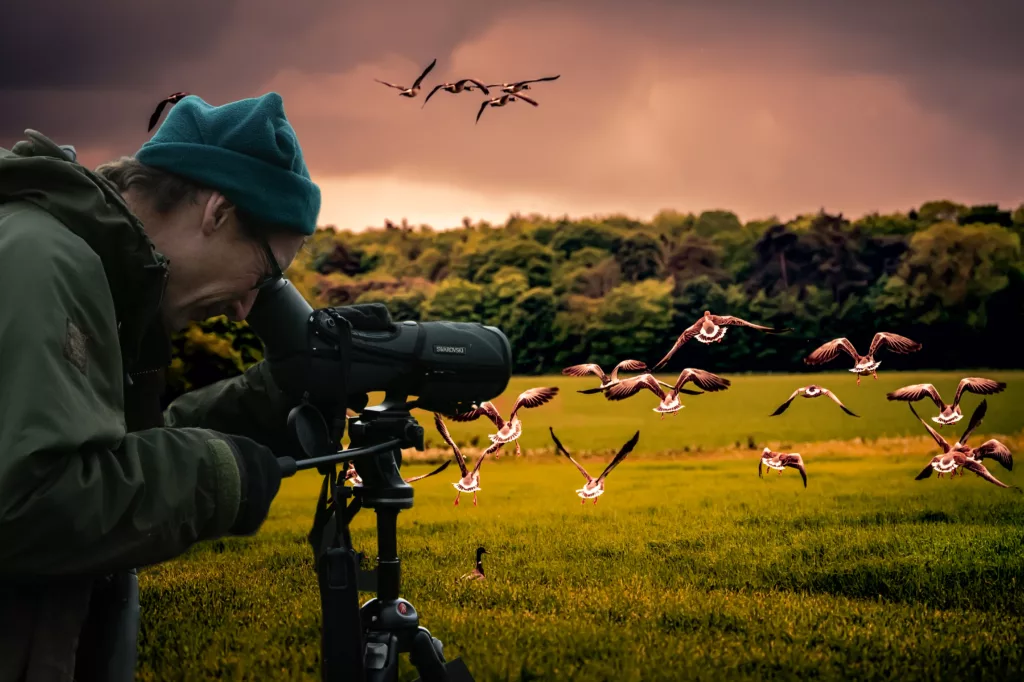
Return of the Geese
The sight of pink foot geese taking flight at dawn is one of nature’s most magnificent winter spectacles. But if prising yourself from bed on a frosty morning is just too painful, you can still witness the geese returning to their roosting grounds as the light fades to dusk. Numbers have been increasing over the last 50 years, with upwards of 100,000 now wintering in Norfolk.
During the day the geese are scattered across the Norfolk fields, shy and hard to spot, moving in grey clusters over the muddy land where they grub for sugar beet tops, searching for root crops rich in carbohydrates. But at the end of an autumn or winter afternoon, try waiting on Lady Anne’s Drive at Holkham. Watch the landward horizon, for this is where they’ll appear. Listen for their calls, piercing the leaden sky until a faint V-shaped skein comes into view. Keep your eyes on it until you see a multitude, fluctuating as formations take turns to lead the flocks.
The skies grow loud and shapes become sharper as they close the distance towards you, arriving in waves. The air is alive with noise, a rowdy hubbub of gathering geese. It’s a little like a starling murmuration, except these birds are almost as big as swans. Then they drop onto the marsh, hoards from the Icelandic Highlands plunging in wheeling spirals. They land. And suddenly it’s silent. You’ve witnessed something truly extraordinary. Now…time to find a nice warm pub!
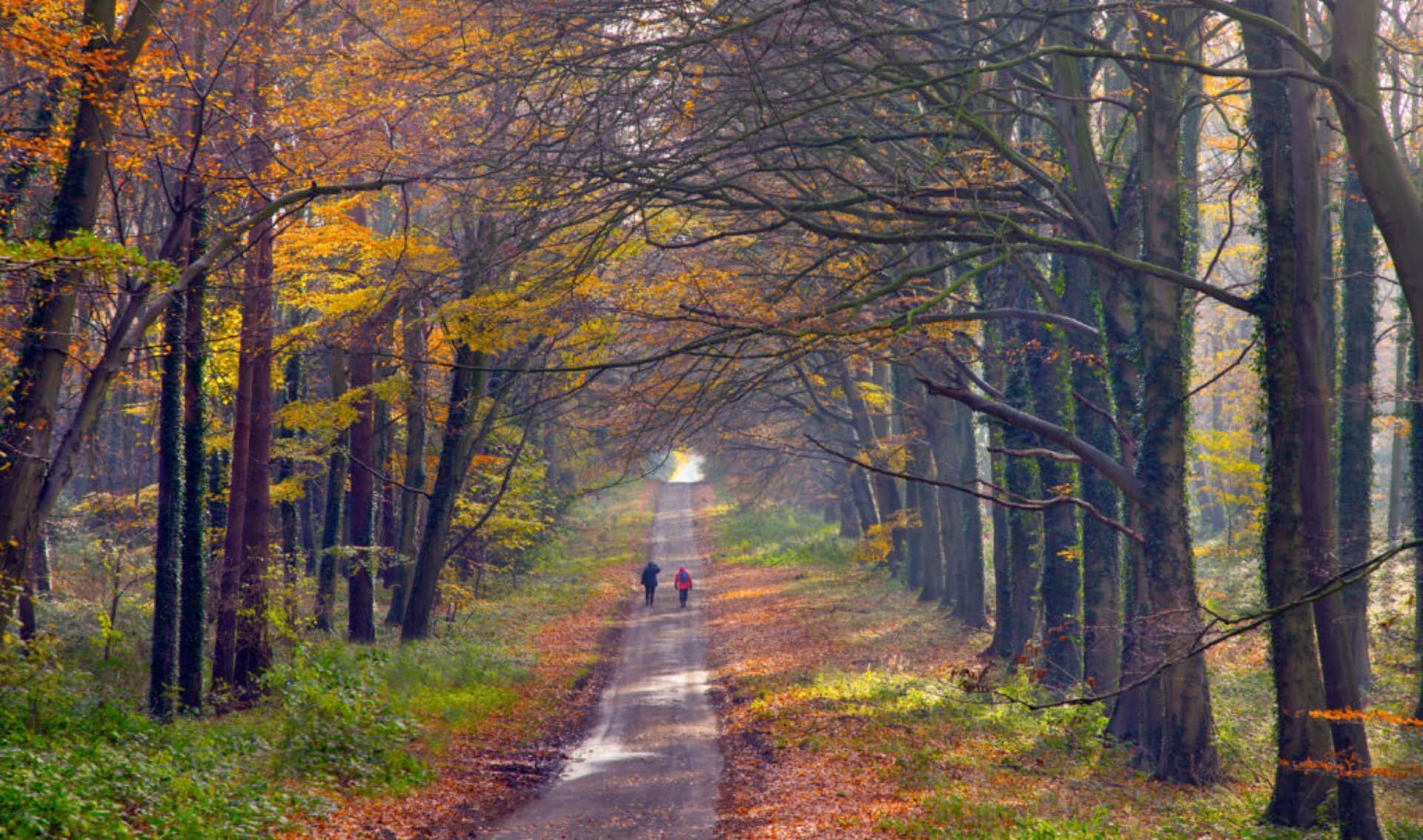
The Great Improvers
There are some fabulous walks in West Norfolk. But once these rolling fields were very different. An open heathland of heather and gorse stretched from King’s Lynn to Holkham, considered a ‘waste’, good for little but rabbits and sheep. Pubs named ‘The Woolpack’ or ‘The Lamb’ recall the ancient the wool trade, but that was before the 18th and 19th centuries, when Norfolk became the wellspring of the Agricultural Revolution.
Gentlemen farmers like Charles ‘Turnip’ Townshend, the Walpoles at Houghton and Thomas Coke, 1st Earl of Leicester, at Holkham, innovated what’s now known as the Norfolk four-course system of crop rotation. It greatly increased yields by allowing the land to rest, improving soil fertility instead of exhausting it by repetitive planting of the same crop. They also experimented with sheep and cattle, breeding massive animals for size and weight. Norfolk’s heathlands were (controversially) enclosed and transformed into productive farmland by marling, ploughing, fencing and building new model farms to reduce waste. Back then it was all about feeding the nation; today good soil care is part of tackling climate change.
And Holkham Estate is again setting the pace, proving profitable food production goes hand in hand with successful wildlife conservation. Tom Coke, the 8th Earl, is as passionate as his ancestor, part of a new generation of Improvers, with environmental stewardship and regenerative farming to the fore. Find out more in the beautifully written memoir ‘Land Healer’ by Jake Fiennes, conservation manager at Great Farm on the Holkham Estate.
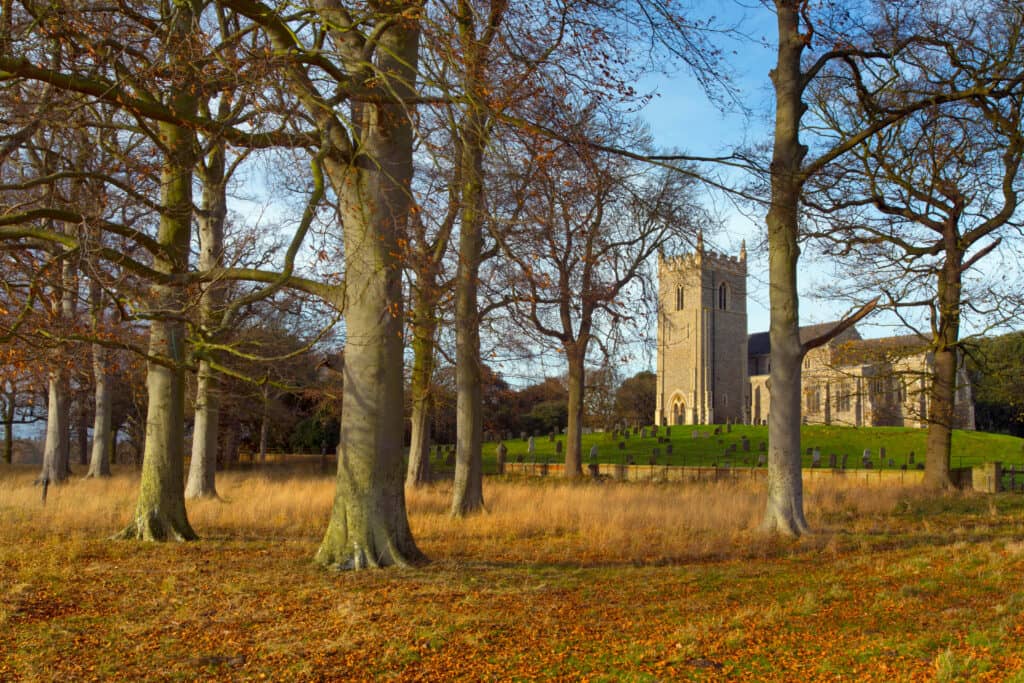
Holkham Park
The rising of the sun and the running of the deer…the idyllic landscape of Holkham and its magnificent Hall is a quintessential 18th century vision of England. Blending natural land with cultivated garden, the rolling green vistas were designed by William Kent, whose principle was ‘nature abhors a straight line’. Drawing from Nero’s Golden Palace in Rome, Ancient Greece and Egypt, the grounds and house express classical Palladian influences, with restrained architecture surrounded by parkland of grass meadows and woods, similar to a medieval deer park. Park making was all the rage in the 18th century, with new ones appearing all over the country, often incorporating a folly, temple, ilex grove, archway, tumbling stream or lake sparkling in the distance, particularly popular in Norfolk where over one hundred landscape parks were shown on Faden’s map of 1797.
Enter the gates and instead of heading along the single-track road towards the Hall, try turning left. Follow the path along the edge of the park, through woods of oak, horse chestnut and beech, framing the Holkham Hall like a landscape painting. You may come across fallow deer, lifting their dark eyes to meet your gaze, or green woodpeckers rattling out a laughing call. If you look very carefully, you might spot a tree creeper, climbing mouse-like up vertical tree boughs.
When evening light slants low through the trees, head for the Victoria Inn’s warmth and settle in for fine food, red wine and a long winter night.
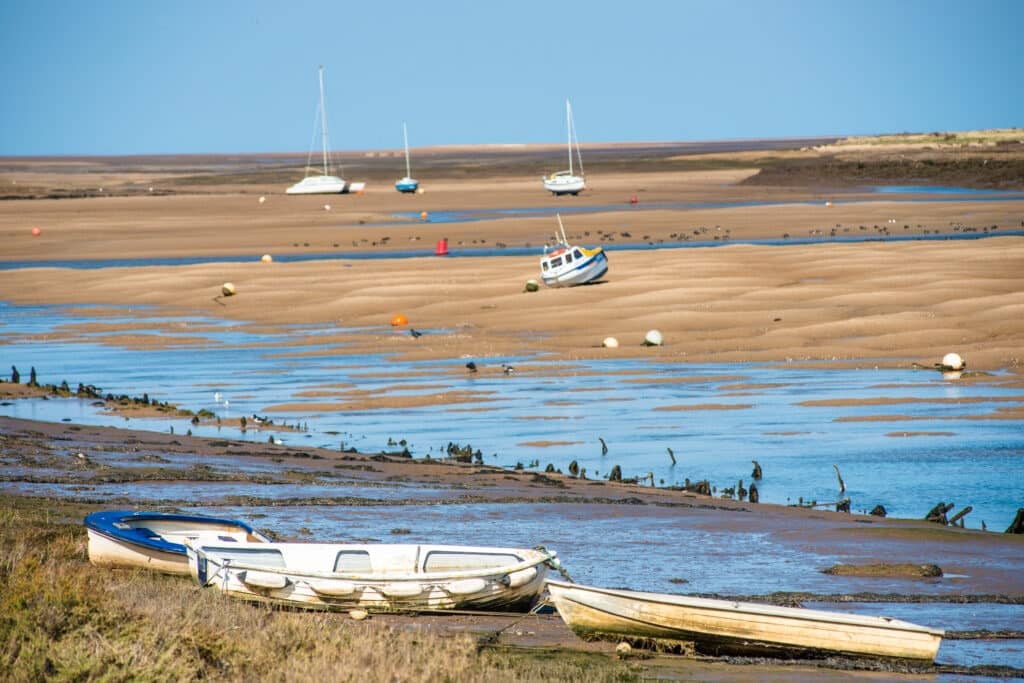
Dawn Flight
It’s bitterly cold. Yet January is an excellent time to head outside and witness one of Britain’s most magnificent dawn experiences. Huddle in the shelter of sand dunes or a Wells beach hut. And wait.
Light glimmers in the east. Day is breaking and with it, an awakening. Ragged cries spike the dark silence. Slowly, quietly it begins. Excitement mounts in rousing crescendos, spreading among thousands of wildfowl, restless on the cold mud.
And then they rise. A wild chorus fills the air, elemental and unrelenting. Thousands of pink footed geese lift almost as one continuous wave of breathtaking joy. Great skeins make V patterns overhead, calling all the while, formations shaping the fading dark. Over the watchers they fly inland, hungry from their night fast, searching for sugar beet tops in newly harvested fields.
In the not too distant past, wildfowlers lined up here, guns loaded to shoot the birds down. Professional wildfowling guides were a cutthroat bunch, guarding their secret shooting locations well. Around this time, Sir Peter Scott, son of the polar explorer Robert Falcon Scott, wrote his book Morning Flight, describing being here as a pilgrimage. His love of such glorious natural spectacle surely informed his work as a conservationist. He established the Wildfowl and Wetlands Trust (WWT) in 1946 and later co-founded the World Wildlife Fund.
And so, morning has come and the geese are off to find breakfast. Time you head back to the warmth of Wells and do the same!
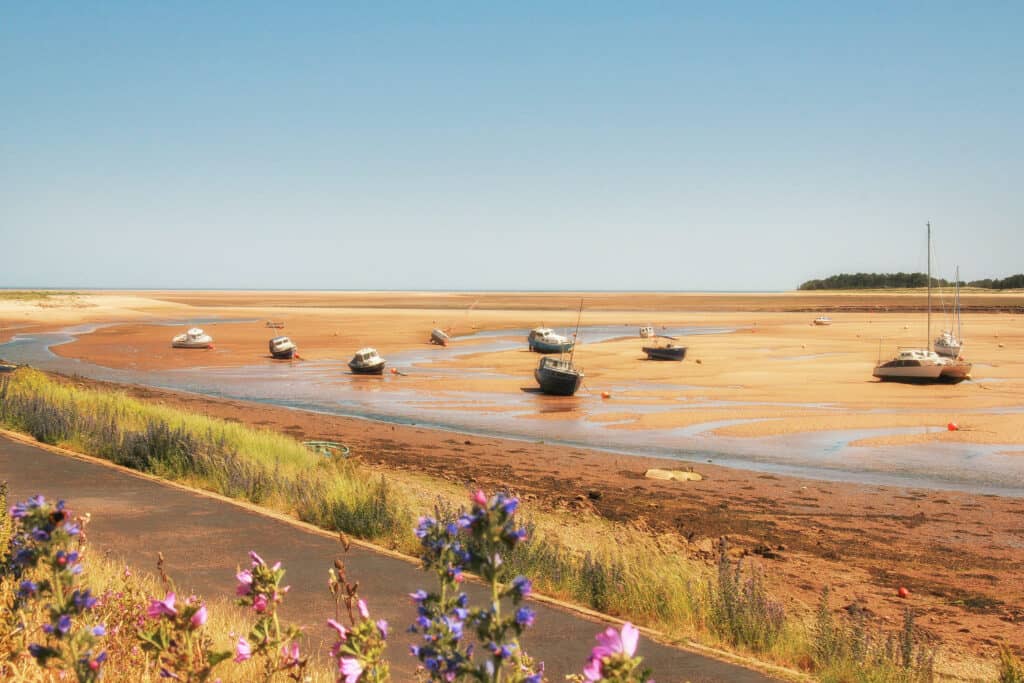
The Cavalry Charge of Wells
Wells Next The Sea, a friendly town, where law abiding folk go about their private business. Take a walk out to the golden sands. Peaceful, isn’t it? Let’s wind back a couple of hundred years.
It’s 1817. A big day out. There’s a town horse race on the sands. Everyone will be distracted. Especially the ‘preventative men’, Customs and Excise officers, perpetually trying to outwit local smuggler gangs. But one man’s criminal is another’s hero, bucking the system to avoid paying taxes to the crown. Swaggering ‘Free traders’ were quite open about their illegal activities. After all, a mix of violent threat and local support gave them licence to behave as they liked. Certainly, the vast majority of those who lived in and around the tiny villages of Blakeney, Stiffkey and Wells benefited from this tax-free trade. Indeed, it was often funded by wealthy local venturers.
So John Dunn, leader of the smugglers, planned to land his contraband during the horse race, an audacious crime committed in plain sight. But the prevention officers weren’t that stupid! They tried to seize the barrels and were immediately attacked by the lawless gang. A yeomanry Major happened to be in the crowd and ordered his men to pile in. The cavalry charged full pelt into the fray, clouting locals across the head in a pitched battle. It was mayhem!
Oddly, the gang still escaped with most of the barrels. And, we reckon, a jolly good evening was had by all.
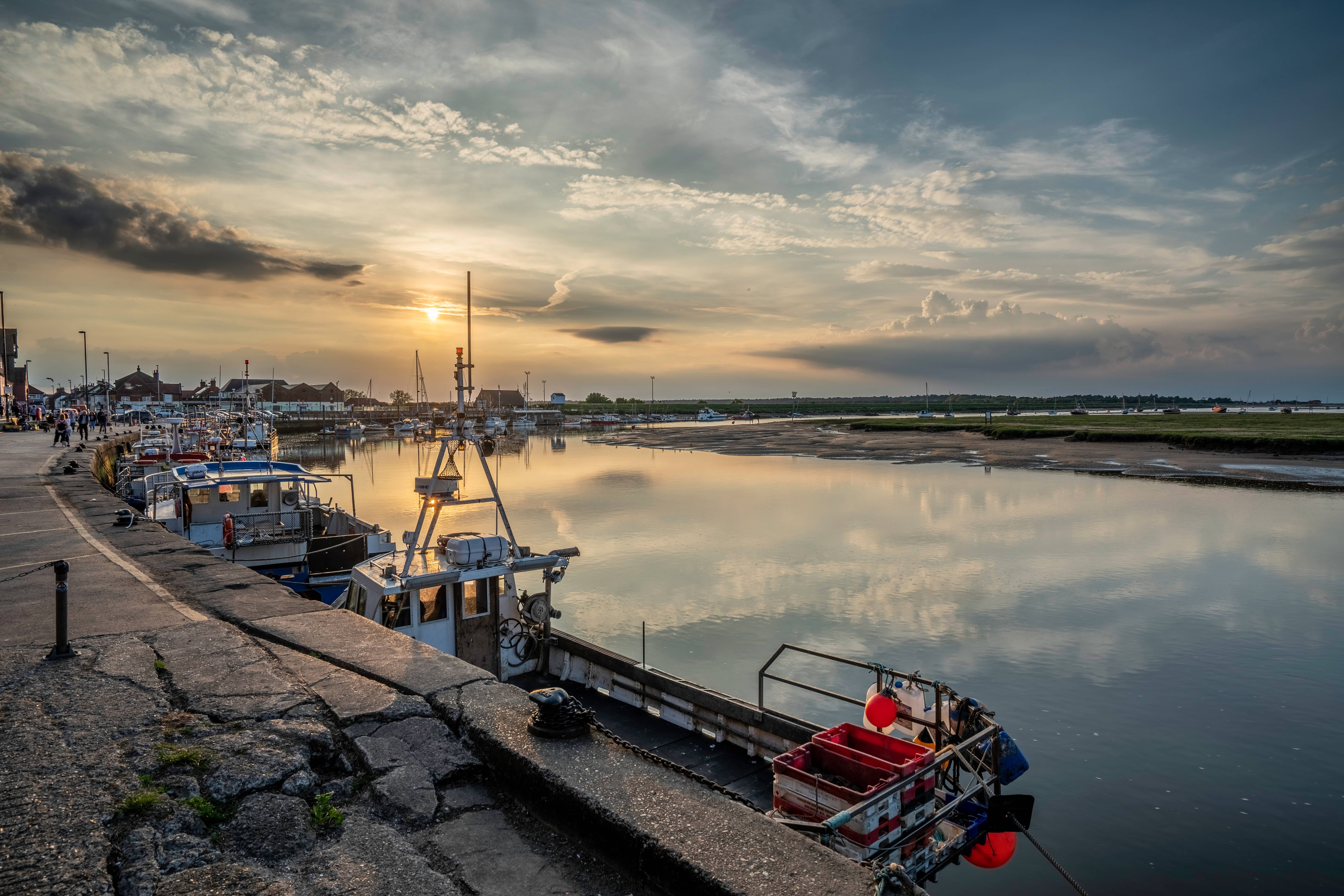
Fresh From the Sea
The small working harbour at Wells-Next-The-Sea has stunning views over shining mud creeks, shifting sand and wild saltmarsh. In winter inky black Brent geese fly low over the reeds and the masts of huddled dinghies, wrapped in their winter coats, clatter in the salty wind. Look out for the ‘Lifeboat Horse’ created by artist Rachel Long to honour the heroic horses who pulled lifeboats to the sea during the 1800s. The quiet winter season is a magical time to explore the narrow sheltered streets winding up from the blustery quayside.
If heavy weather rolls in, cosy up at Wells Maltings on Staithe Street. It features a state-of-the-art theatre, cinema, fabulous café, Heritage Centre, Visitor Information Centre, modern art gallery and spaces for community classes and events. With such a vibrant arts scene you’ll hope it rains again tomorrow! Don’t miss the giant whelk sculpture, which brings us to shellfish.
For thousands of years cold water currents have swept nutrients from Norway, resulting in a rich variety of seafood along the Norfolk coast. October to March, the cold weather season, is when the town’s mussel beds are seeded, ready to be harvested after 2.5 years. It’s hard work, but dedication and passion ensure Norfolk’s world class seafood. Wells has plenty of places to seek out these winter feasts from the sea. Try the Wells Crab House, Nelson’s Coffee House, Sands, Ollie’s, and Season. Where do they get their ingredients? All fresh from the sea!

Wells Harbour Tour
Wells-Next-the-Sea is a charming fishing port on the north Norfolk Coast. From the magnificent sandy beach fringed by fragrant pinewoods and jaunty wooden huts, around the bustling quayside where fishermen unload their catch opposite the finest fish & chips on the coast, to the ‘The Buttlands’, a pretty, leafy green with warm & welcoming inns – Wells is the perfect seaside destination.
What better way to take in the sights and sounds than by boat trip? At Wells Harbour Tours Nick and his friendly team welcome you aboard the ‘Wells Ferry’, built in a boatyard just along the coast. Seeing the harbour from the water gives you a unique seafarer’s perspective. And look out for the Wells Harbour Horse!
On the Beach Trip, you’ll head down the channel to the open water for a fantastic view of the coast and town, hearing about local landmarks and stories. You’ll visit the Outer Harbour, RNLI station and beach, surrounded by the cry of sea birds and sound of the waves. If you’re lucky you might even see a few seals popping up!
The Marsh Trip is a gentle journey through the wilds of Wells Salt Marsh, an environmentally protected nature reserve, home to many important birds and plants. As you pass the whelk sheds, returning to the east end of the Quay, you’ll have a real sense of how human livelihoods are bound together with nature in this uniquely beautiful place.
Most trips last an hour, with flexible options.

Living History, The Dunkirk Little Ship
Discover the true story of a Second World War heroine and meet the old gal herself! The Lucy Lavers is a veteran of ‘Operation Dynamo’, one of the little boats who crossed the Channel in 1940 to rescue stricken soldiers, trapped in the chaos of battle on the beaches of Dunkirk.
What better way to experience living history than by taking your own trip on this amazing little boat?
The Lucy Lavers was one of two Aldeburgh RNLI vessels to cross the Channel. She made her way to Ramsgate where she was requisitioned by Royal Navy crews for the heroic crossing. For Lucy Lavers, it was her first action after coming on station earlier in May that year. Records describe her being towed across the Channel before picking up her precious cargo of soldiers, who’d stood up to their necks in water waiting for help to come.
The newly formed Curlew Coastal Charters is based at Wells Next The Sea and will be running Lucy Lavers on behalf of Rescue Wooden Boats, led by experienced local skipper Liam Pink.
During the 1.5 hour cruise around Wells Next The Sea harbour, you’ll hear stories of Lucy Lavers and the Dunkirk Little Ships, and also tales of the local RNLI where twice she was the town’s relief lifeboat. You’re likely to see curious seals pop up their heads to listen and elegant curlews probe the mud for shellfish, peaceful scenes so starkly different to that battle torn beach in France.
Build your own itinerary
If you fancy creating your own itinerary for a day trip to Norfolk or a longer visit, it couldn’t be simpler. Just go to Search Activities and select from our wide range of free and paid-for experiences, saving any that capture your imagination with the click of a button.
Once you’ve finished, you’ll find all the information stored in My Favourite, where you can drag and drop activities to create your own day-by-day itinerary! You can download this to a calendar and even share it with friends.
